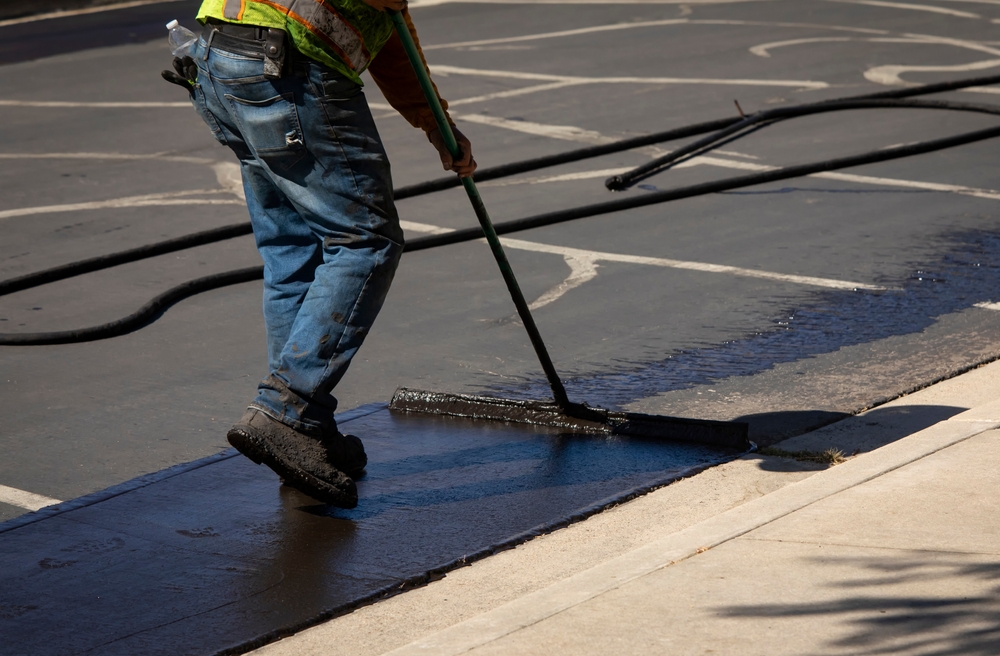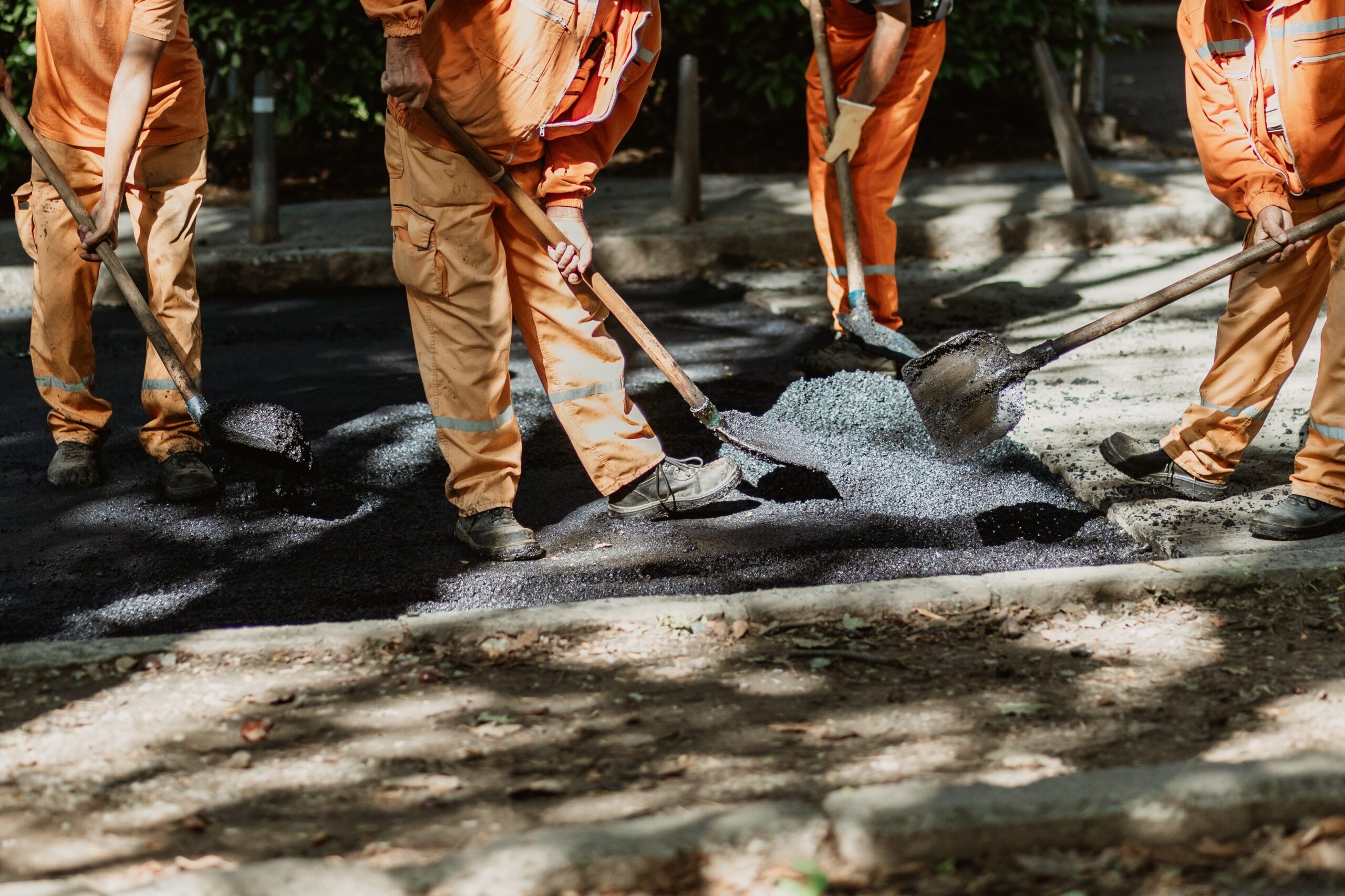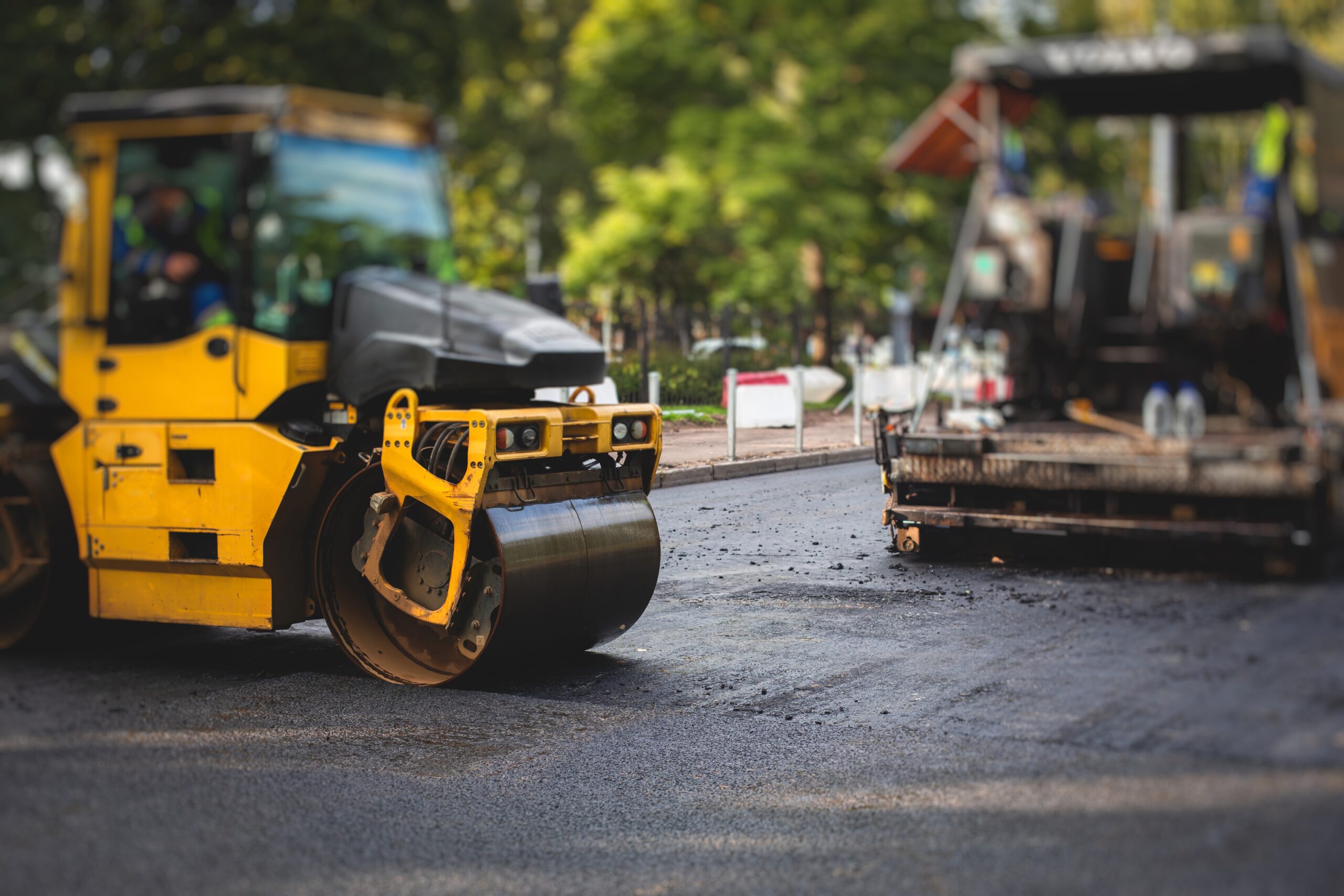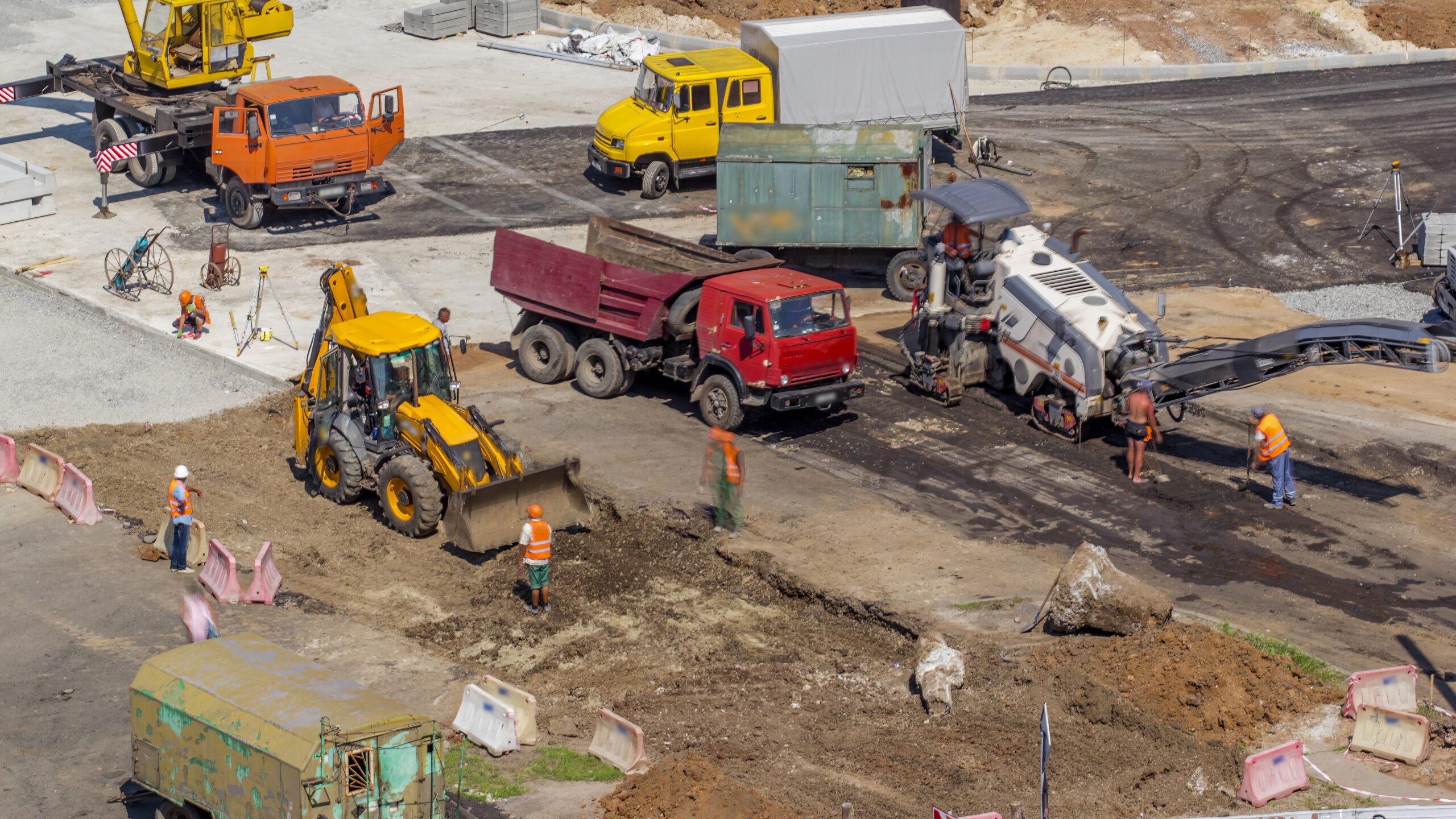
Sealcoating gives asphalt a fresh, clean look while protecting it from weather, wear, and spills. However, achieving a smooth, lasting finish requires more than just the right materials. Timing is everything, and the weather can make or break the results.
If the sealant goes down in cold, humid, or rainy conditions, it may never cure properly. That leads to streaks, flaking, or early wear. Even sun, wind, and temperature swings can affect how the sealcoat bonds to the surface.
In this guide, we explain how key weather conditions impact sealcoating. With thoughtful planning and a close eye on the forecast, you can protect your investment and get a finish that lasts.
Why Sealcoating Matters for Asphalt Protection
Sealcoating is a protective treatment applied to asphalt to shield it from environmental damage, moisture, and wear caused by traffic. It acts as a barrier that keeps water from seeping in, protects against UV rays, and helps prevent damage from oil or chemical spills. It also revives the appearance of asphalt with a smooth, dark black finish.
Benefits of sealcoating:
- Extends asphalt lifespan by 3 to 5 years
- Helps prevent cracking, potholes, and erosion
- Enhances curb appeal with a refreshed, even surface
When applied correctly under proper conditions, sealcoating adds tremendous value. With many climate-related variables at play, timing your project correctly makes all the difference, which is why knowing the best time to sealcoat your commercial parking lot is essential.
Understanding the Sealcoating Process
To appreciate how weather influences sealcoating quality, it’s essential to understand the stages of the process.
Drying vs. Curing
Drying is the initial phase when the surface becomes dry to the touch. This typically takes 24 to 48 hours.
Curing refers to the complete hardening of the sealant, which can take 72 hours or more, depending on the temperature, humidity, and exposure to sunlight.
If any part of the process is rushed or impacted by unfavorable weather, the result is often uneven coverage, poor adhesion, or flaking.
Why Weather Plays a Role
Sealcoat is made up of water, bitumen, and additives. The water must evaporate for the material to bond correctly. If the weather is too cold, too humid, too wet, or too windy, the curing process is delayed or compromised.
How Temperature Affects Sealcoating Quality
The ideal range:
- Best results occur between 50°F and 90°F
- The sweet spot lies between 70°F and 85°F, where surface temperature supports even curing
If it’s too cold:
- Below 50°F, the sealcoat can fail to bond to the asphalt
- You may see peeling, flaking, or uneven color.
In extreme heat:
- Above 95°F, the sealcoat dries too quickly on the surface
- Overheating can cause cracking or uneven material flow.
Weather tip: Monitor both air and surface temperatures. The ground often lags behind the ambient temperature, especially in the early morning. This is one of the key factors that affect asphalt construction costs.
How Humidity Impacts Sealcoating
High humidity slows down evaporation, keeping moisture in the sealcoat for a longer period.
Optimal humidity:
- Stay below 60% whenever possible
- Humid days can double the curing time.
Problems with high humidity:
- Uneven curing
- Sticky finish
- Streaking or blemishes
Weather tip: Avoid sealcoating on muggy days or right after rainfall, even if the sun is out.
Why Sunlight Is Crucial for Sealcoating
Sunlight powers evaporation. A bright, sunny day helps sealcoat dry faster and more evenly.
Clear skies improve:
- Water evaporation
- Drying speed
- Sealant adhesion
Watch for cloud cover:
- Overcast skies slow drying
- The sealant may remain soft.
- Uneven sheen or mirror-like spots may appear.
Weather tip: Aim for full sun for at least six to eight hours after application. This timing is critical when considering the best time to pave commercial driveway.
How Rain and Moisture Affect Sealcoating
Moisture is one of the biggest threats to a successful sealcoating job.
Rain risks:
- Rain within 24 hours can wash away the uncured sealant
- Even overnight dew can cause curing issues.
Surface condition:
- Do not sealcoat if the surface is still damp
- Small puddles can lead to early failure.
Weather tip: You’ll need at least 24 to 48 hours of dry weather before and after sealcoating.
How Wind Influences Sealcoating
Wind can either help or hurt, depending on its strength.
When wind helps:
- A light breeze moves moisture off the surface
When the wind hurts:
- Wind over 10 mph can blow debris into wet sealant
- It can interfere with the smooth application.
- It may strip away sealant particles.
Weather tip: Choose a calm day for the cleanest, most consistent results, which is part of ensuring how weather and temperature impact asphalt paving quality.
Seasonal Timing for Sealcoating Success
Plan your sealcoating project during the seasons with the most stable, dry weather.
Best times by region:
- Northern states: May to early September
- Southern states: March to November
Why season matters:
- Spring and fall mornings may be too cold
- Rain is more common during the shoulder seasons.
Weather tip: Consult local experts who understand your area’s seasonal patterns and climate behavior.
Common Mistakes to Avoid
Applying in bad weather:
- Cold, wet, windy, or humid days can cause poor coverage and early failure
Allowing traffic too soon:
- Cars or pedestrians within 24 hours can damage the surface
- Tire marks and scuffs can become permanent.
Skipping surface prep:
- Dirty or cracked asphalt prevents proper bonding
- Unfilled cracks weaken the entire sealcoat
Take the time to thoroughly prepare the surface. It pays off with longer-lasting results.
Expert Tips
- Check the forecast before starting
Look for at least 48 hours of clear, sunny, dry weather before and after the job. - Clean and prepare thoroughly
Clear debris, clean stains, and repair cracks before applying the sealant. - Use high-quality sealcoating products.
Premium materials cure more evenly and last longer. - Learn from others
One Texas property owner delayed their project by three days based on a rain forecast and saved over $1,500 by avoiding rework. - Don’t guess
When unsure, call a professional. The proper prep and timing today will keep your asphalt looking its best for years.
Checklist for Ideal Sealcoating Conditions
Check these key weather conditions before sealcoating to achieve the best results:
| Weather Factor | Ideal Condition | Why It Matters |
| Temperature | 50°F–90°F (70–85°F ideal) | Ensures proper adhesion and curing |
| Humidity | Below 60% | Prevents slow drying and tacky surfaces |
| Sunlight | Direct sunlight | Helps cure evenly and quickly |
| Rain | None for at least 24–48 hours | Prevents washout or weakening of the sealant |
| Wind | Below 10 mph | It avoids debris and ensures a clean application |
| Cloud Cover | Minimal | Allows UV rays to support the curing process |
Frequently Asked Questions
What is the ideal temperature range for applying asphalt sealcoat?
The ideal temperature for sealcoating ranges from 50°F to 85°F, with the optimal window typically falling between 70°F and 85°F. This range allows the sealant to bond and cure properly. If temperatures drop below 50°F, the sealcoat may not adhere well to the surface. On the other hand, temperatures above 95°F can cause the sealant to dry too quickly on top, leading to cracks and uneven curing.
How does humidity affect the sealcoating process?
Humidity plays a significant role in how sealcoat dries. Ideal conditions are those with a humidity level below 60%. When humidity is high, moisture evaporates more slowly from the sealant, which extends curing times and can result in a tacky or uneven surface. Trapped moisture may lead to peeling, blistering, or poor adhesion, so it’s best to avoid sealcoating on overly humid, foggy, or damp days.
Why is sunlight important during sealcoating?
Sunlight helps the water in the sealcoat evaporate more efficiently. On bright, sunny days, the surface dries faster and cures more evenly, resulting in a stronger bond and a more aesthetically pleasing finish. Cloudy or overcast weather can slow down this process, leaving the sealcoat vulnerable to scuffs, streaks, or surface imperfections.
Can sealcoating be done if rain is forecasted?
It’s not recommended to sealcoat if there’s rain in the forecast within 24 to 48 hours of application. Rain or even heavy dew can interfere with the curing process, wash away uncured material, or prevent the sealant from adhering correctly to the asphalt. Always aim for a clear, dry weather window when planning a sealcoating project.
How does wind impact sealcoating quality?
Light wind helps the drying process by moving moisture off the surface. But when wind speeds exceed 10 mph, problems can occur. Strong gusts may blow dust and debris into the wet sealant, disturb the even spread of the material, or cause the sealcoat to dry unevenly. For best results, apply a sealcoat on a calm day.
When is the best season or time of year for sealcoating?
Late spring through early fall is generally the best time for sealcoating. In northern regions, this period spans from May to September. In southern states, the window stretches from March to November. These months usually offer warm temperatures, lower humidity, and fewer rainy days, all ideal conditions for a successful sealcoating job.
Protect Your Investment with the Right Timing
Weather conditions have a direct impact on the success of any sealcoating project. Temperature, humidity, sunlight, and surface moisture all influence how well the sealant cures and bonds. Applying it in poor conditions can lead to streaking, poor adhesion, or premature wear. That’s why timing is everything. At Asphalt Coatings Company, we don’t leave it to chance. We carefully monitor the weather, use professional-grade materials, and prep every surface with precision to ensure the coating sets correctly and delivers long-term protection.
Ready to protect your asphalt the right way? Contact Asphalt Coatings Company today to schedule a sealcoating service you can count on.



